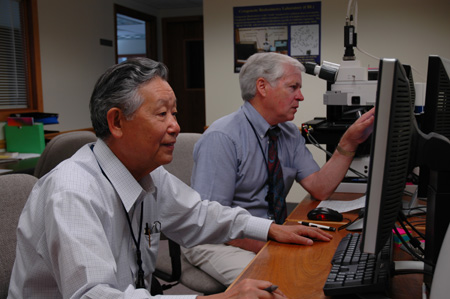
How ORISE is Making a Difference
Hiroshima Fallout Expert Visits Cytogenetic Biodosimetry Lab
Drs. Akio Awa (foreground) and Gordon Livingston checked images of blood culture samples looking for chromosomal aberrations. Dr. Awa visited the Cytogenetic Biodosimetry Laboratory from Hiroshima on a six-month assignment under a contract administered by the Henry M. Jackson Foundation on behalf of the Armed Forces Radiation Research Institute.
Dr. Akio Awa, a native of Hokkaido, Japan, was a visiting cytogeneticist in 2007 at the Radiation Emergency Assistance Center/Training Site (REAC/TS) Cytogenetic Biodosimetry Laboratory (CBL), which is managed by the Oak Ridge Institute for Science and Education (ORISE).
Dr. Awa retired from Japan’s Radiation Effects Research Foundation (RERF), formally the Atomic Bomb Casualty Commission (ABCC) as Chief of the Department of Genetics in 1995. While he has maintained consultant status at RERF, he spent six months analyzing blood cultures at the CBL alongside Drs. Gordon Livingston and Mark Jenkins of ORISE.
Dr. Awa is widely considered to have performed the most extensive radiation cytogenetic population studies in the world, including nearly 30 years spent studying the effects of “Little Boy,” the nuclear bomb dropped on Hiroshima on Aug. 6, 1945.
Below is a question and answer dialogue about Dr. Awa’s background and interest in cytogenetics.
Q: You were young when the atomic bomb was dropped on Hiroshima. What effect did that event have on you and any interests you had in studying human genetics?
A: I was always interested in genetics, mostly of vertebrate animals such as mice and rats. I was in sixth grade and living in my hometown of Sapporo, Hokkaido (about 1,500 miles from Hiroshima) when the bombs were dropped. We didn’t know about the event until two days later. It was seven or eight years until we knew more details about what happened.
At that time, no one knew much about radiation and the possible effects from exposure. I was unaware of the seriousness of the bombings until I began working for the Atomic Bomb Casualty Commission (ABCC) in 1967.
Q: As a child, what drew you to be interested in animal genetics?
A: When I was a kid, I was not science-minded. I wanted to be a cartoonist. When I went to the university, since my brother was an internist—a physician—my father wanted me to be a physician, so I was forced to choose a scientific department. When I got into the science department I was satisfied with it. I had no desire to study medical courses, so I turned to science, and I had more interest in animal genetics.
Q: Tell us about the research you did for ABCC in Hiroshima.
A: I began working in cytogenetics in 1956 at Hokkaido University, looking for chromosome aberrations in leukemia patients undergoing treatment. The studies were looking for aberrations resulting from the drugs used for treatment.
In 1967, I was recruited into radiation cytogenetics by ABCC to work on the atomic bomb survivor cytogenetic studies. I focused on two projects while with the ABCC, which was eventually reorganized into the RERF in 1975. I studied blood cultures of A-bomb survivors looking for any chromosomal aberrations that may have resulted from the event.
I also studied blood cultures from children of survivors, looking for any genetic effects, hereditary problems and/or increases in mutative diseases.
Over 16 years with the agency, I studied cultures from 16,000 children—8,000 children of A-bomb survivors and 8,000 children whose parents were not exposed to the atomic radiation—and we showed that, at that time, no ill effects of radiation were observed in the children.
Q: How did Dr. Livingston track you down and bring about your collaboration with the CBL in Oak Ridge?
A: Dr. Livingston began e-mailing my successor at RERF in 2004 about my experiences using Giemsa staining and karyotyping of chromosomes. Dr. Livingston was trying to find out if Giemsa staining would be a suitable alternative to chromosome painting—a painstaking and expensive process—for old blood cultures from U.S. nuclear workers he had not yet evaluated.
Once I received Dr. Livingston’s e-mail from RERF, he and I began communication regularly, sharing cytogenetics-related notes and opinions. We continued our communication until we met in Bethesda, Md., for a biodosimetry conference in July 2006. After the conference I visited Oak Ridge for the first time for a meeting of the CBL Scientific Advisory Board. Then we began making arrangements for me to visit the CBL as a guest cytogeneticist.
****
Before returning to Hiroshima, Dr. Awa traveled with Drs. Jenkins and Livingston to attend the Cytogenetic Biodosimetry Workshop sponsored by the Armed Forces Radiation Research Institute (AFRRI) and held at the Uniformed Services University of the Health Sciences in Bethesda, Md.
Dr. Awa hopes to be able to work with the CBL again, possibly via the Internet from Japan. He also hopes to return to the United States in the future for further travel and possible collaborations with the CBL.
